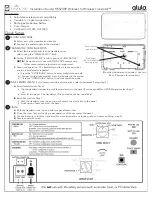
Page
7
of
19
4. PRINCIPLES OF OPERATION
The ultrasonic power supply transforms AC line power to a 20 KHz signal that drives a
piezoelectric converter/transducer. This electrical signal is converted by the transducer to a
mechanical vibration due to the characteristics of the internal piezoelectric crystals.
The vibration is amplified and transmitted down the length of the horn/probe where the tip
longitudinally expands and contracts. The distance the tip travels is dependent on the
amplitude selected by the user through the keypad.
The ultrasonic vibrations are intensified by the probe and focused at the tip where the
atomization takes place. The liquid travels through the converter and the probe, and spreads out
as a thin film on the atomizing surface of the probe. The oscillating probe tip disintegrates the
liquid into micro-droplets, and ejects them to form a gentle, low velocity spray.
Unlike conventional atomizing nozzles that rely on pressure and high velocity motion to shear a
fluid into small drops, the ultrasonic atomizer uses only low ultrasonic vibrational energy for
atomization. The liquid can be dispensed to the atomizing probe (nozzle) by either gravity or a
small low-pressure metering pump, and atomize continuously or intermittently. The rate at which
the liquid is atomized depends, within limits, solely on the volume that is being delivered onto
the atomizing surface, and the frequency. The amount of material atomized can be as little as 2
µl/sec.
A wide variety of coatings, chemicals, lubricants, and particulate suspensions can readily be
atomized. However, factors such as viscosity, miscibility, and solid content deserve
consideration. For optimum atomization, the viscosity should be under 500 cps and the solid
concentration kept below 30%. Because the atomization process depends on setting a liquid
film into motion, typically the higher the viscosity – the lower the flow rate, and the more difficult
the application. The atomization of liquids containing long-chained polymer molecules is
problematic, even in diluted form, due to the highly cohesive nature of the material. In many
cases, mixtures with particulates can be atomized, because the solids are simply carried along
in the drops. The low transport velocity of the liquid through the probe permits even abrasive
slurries to be processed with negligible erosion of the passageway. Compared with conventional
pressurized nozzles, the feed channel running through the probe and exit orifice are relatively
large, and practically impossible to clog.
Drop size is primarily a function of frequency, and the higher the frequency, the smaller the drop
diameter. The median drop size at 40 kHz is 50 microns. Atomizing probes are one-half
wavelength long tools that act as mechanical transformers to increase the amplitude of vibration
generated by the converter. They are fabricated from high grade titanium alloy Ti-6Al-4V
because of its high tensile strength, good acoustical properties at ultrasonic frequencies, high
resistance to corrosion, low toxicity, and excellent resistance to cavitation erosion.





































